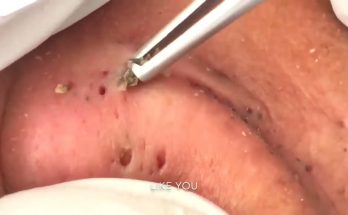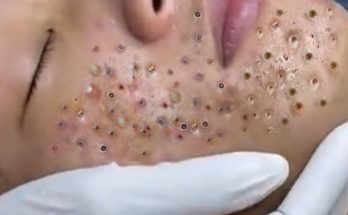How to Treat and Prevent Deep Blackheads — Professionally or at Home
Plenty of people would count blackheads among the most common — and most stubborn — skin conditions. This type of acne develops when oil (sebum) and dead skin cells combine to form a plug that clogs your pores.
Sometimes, cleansing and exfoliating may be enough to loosen the plug and draw it out. But if the plug hardens, or it’s too deep to access, you might not be able to remove the blackhead on your own.

Below, you’ll find tips on how to use over-the-counter (OTC) products for blackheads, information on what to expect from professional removal, and more.
Your first step should always be to cleanse your face.
Cleansing is best done twice each day: once in the morning and once again at the end of your day. If you work out or get sweaty during the day, you may want to wash your face again afterward.
That said, try to avoid over-cleansing. This can dry out your skin and cause more dead skin cells and sebum to accumulate in your pores.
Tip: If you prefer to wash your face more frequently, try limiting cleansing to morning and evening washes and rinsing with plain water throughout the day to avoid drying out your face.
The type of cleanser you use can also make a difference in blackhead removal and prevention.
Many people prefer gel-based cleansers, which:
- aren’t oily like some cream-based cleansers
- are typically safe for both oily and sensitive skin
A daily cleanser with micro-exfoliants can also help remove dead skin cells.
Exfoliation helps remove dead skin cells, sebum, and other debris from the surface of your skin.
When it comes to physical exfoliants, you have plenty of options, but avoid choosing anything too harsh that will irritate your pores. Ground-up nuts and other harsh beads may irritate active breakouts or sensitive skin.
Consider something simple, like a do-it-yourself (DIY) natural option or an over-the-counter (OTC) scrub with gentle ingredients, like oatmeal.
You’ll generally want to follow the instructions on the product you choose, but this is a good starting place for most exfoliants:
- Apply a thin layer of exfoliant.
- Spread it evenly over your skin.
- Massage — don’t scrub — it into your skin.
- You might need to leave it on your face for several minutes, but check the product package to be sure.
- Once the process is done, rinse off the product completely.
Steam can help loosen the gunk that’s clogging your pores, setting you up for a more effective extraction process. You don’t need a spa steamer to get these benefits, though.
To open your pores with steam at home, try this technique:
- First, boil up to 6 cups of water in a pot or kettle.
- Let the water cool for a minute or two.
- Carefully pour the water into a bowl.
- Sit in front of the bowl, resting your face about 6 inches above the water.
- Drape a towel over your head and the water source to hold the steam in.
- Raise or lower your head for more or less heat. Lift a corner of the towel to cool off, if needed.
- Stay for up to 10 minutes at a time.
Exfoliation and steam help get your pores ready for extraction, but your skin’s not quite ready yet. Applying a mask first can help make extraction even more successful.
Use either a clay or charcoal-based mask. These ingredients help deeply cleanse the pores, and you’ll want to get as much dirt and oil out of your pores as you can before using an extractor tool.
How to do it:
- Apply a thin, even layer of the clay or charcoal mask to your face.
- Leave the mask on for about 15 minutes.
- Rinse your face thoroughly with warm water.
After loosening your pores and applying a mask, you can try extracting deep blackheads yourself.
Here’s how:
- Sterilize your extractor tool with rubbing alcohol.
- Press the loop face down on the edge of the blackhead you’re trying to remove. Just avoid pressing directly down in the middle of the blackhead, as this can irritate your pore.
- Once you’ve got the head of the tool in place, make a gentle sweeping motion to the other side of your pore.
- Repeat up two more times if you don’t get the plug out the first time — any more than this can irritate or damage the surrounding skin.
Always sterilize your tool between uses to prevent the transfer of dirt and bacteria between pores.
After extracting debris from your pores, it’s important to soothe your skin to prevent inflammation. You can do this with a cooling gel mask or face serum.
When choosing a mask or serum, opt for anti-inflammatory ingredients such as green tea, vitamin E, and almond oil. Apply a small amount in an even layer.
If you’re using a gel mask, rinse after use and follow up with the rest of your skin care routine.
Squeezing out a blackhead might feel tempting, especially if you can’t safely extract it the first time around.
But the advice you’ve probably heard before is true: You really shouldn’t pinch, poke, or squeeze out a blackhead, since this can potentially lead to:
- irritation
- pores that appear larger
- scarring
What about pore strips?
Although pore strips are touted as a way to remove blackheads without picking, they often do more harm than good.
These strips target surface debris, which often does little to resolve deep blackheads. They can also dry out and irritate your skin.
Although a quick internet search might reveal dozens of “home remedies” for blackhead removal, none have been proven to work.
In fact, some of these purported remedies might even make your acne worse.
If you do decide to try a home remedy, exercise extreme caution. Performing a patch test by applying the substance on your forearm first and waiting overnight can help you gauge how your skin will react.
Home remedies that can be harmful
Certain everyday ingredients recommended as blackhead “remedies” can do more harm than good.
These include:
- apple cider vinegar
- baking soda
- Epsom salts
- lemon
- toothpaste
Many people believe these ingredients help absorb oil and get rid of dead skin cells. The problem is, they may be too drying, so using them can lead to irritation, swelling, and more breakouts.
Home remedies that might not be effective
Some purported remedies aren’t necessarily harmful — they just might not always work.
These include:
You’ll often find these ingredients in recipes for homemade masks because of their antioxidant and hydrating properties — but these benefits won’t do anything for deep blackheads.
Unless you’re experiencing severe pain or swelling, professional removal usually isn’t necessary.
If you’re not getting the results you want at home, consider making an appointment with a dermatologist or aesthetician to talk about your concerns.
They may recommend one of the following removal techniques:
Professional extraction
After making a small hole in the clogged pore, your dermatologist or aesthetician will remove the plug with a looped-end metal extractor tool.
Microdermabrasion
Microdermabrasion offers deeper exfoliation than OTC options, like scrubs.
A dermatologist or aesthetician will use a crystal-emitting handpiece to gently spray fine crystals onto the skin. The device will rub and suction off the outer layers of dead skin. They may also use a diamond-tip handpiece to exfoliate more sensitive areas, such as around your eyes.
This technique may also help reduce the appearance of enlarged pores.
Chemical peels
A professional chemical peel removes the entire top layer of skin, reducing blackheads and other debris.
Just keep in mind that your skin may be more prone to sunburn during the recovery process. When spending time outdoors, you’ll want to take extra caution to protect your skin from the sun — sunscreen is essential, but a hat can’t hurt, either.
Laser therapy
Laser therapy is sometimes used on breakouts that don’t respond to other treatments.
For deep blackheads, dermatologists use photopneumatic therapy. The process involves a combination of intense pulsed light lasers and a hand-held vacuum.
Using these together allows your dermatologist to get deep into your pores to remove dead skin cells and excess sebum.
For best results, the American Academy of Dermatology recommends one or two follow-up sessions per year.
Deep blackheads can take time to remove safely and effectively. Once you’ve got the gunk out, the strategies below can help prevent them from coming back.
- Use noncomedogenic products. Noncomedogenic is code for “non-pore-clogging.” Also look for oil-free sunscreens and lotions to help prevent clogged pores.
- Remove makeup before bed. Cleansing at night helps remove makeup, but sometimes residue is still left behind. Consider adding a pre-cleanser to remove all your makeup.
- Wash your hair regularly. Not only will your locks stay healthy and soft, but you’ll also get rid of oils and dirt that can get on your face and clog your pores.
- Be sure your hands and nails are clean. Keeping your nails clean can help minimize dirt and oil transfer.
- Wash your pillow cases and bedding. Aim to wash these once a week to get rid of any dirt and oil on your sheets.
- Add salicylic acid to your skin care routine. Salicylic acid dries out dead skin cells that accumulate in your pores, thereby decreasing the chances of blackheads. Try a face wash, toner, or moisturizer that contains salicylic acid to get these benefits.
- Consider glycolic acid. Regular use can help your skin shed dead skin cells, preventing clogged pores. You can find glycolic acid in moisturizers and OTC peels.
- Ask a dermatologist about prescription retinoids. Retinoids are derivatives of vitamin A. While primarily recommended for inflammatory acne, they may also help control excess oils that contribute to blackheads.
- Avoid overusing acne products. Combining several products that contain salicylic acid, sulfur, benzoyl peroxide, and other acne-treating ingredients can dry out your skin. Ironically, this can cause more blackheads, because overly dry pores may end up producing more sebum to help hydrate your skin.
- Eat a balanced diet. Certain foods and nutrients — including dark green and yellow vegetables and fruits, omega-3 fatty acids, and whole grains — can promote overall skin health. Drinking plenty of water can also help balance out sebum and aid in skin cell turnover.
Getting rid of blackheads often proves something of a challenge, but it’s definitely possible — one or more of the home removal techniques mentioned above could make a difference.
That said, if you don’t see improvement within 6 weeks, consider making an appointment with a dermatologist or aesthetician to learn more about your options for professional treatment.


